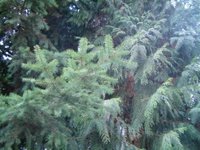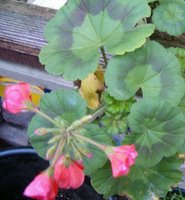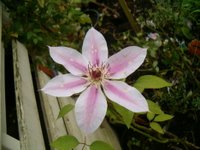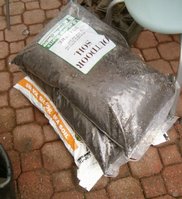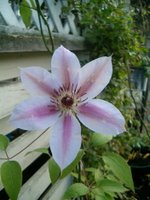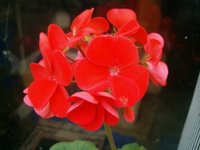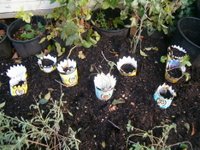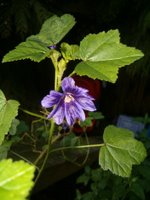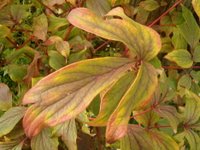
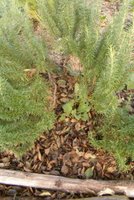


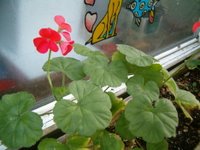



Two Feet of Snow--Tassels and Ears
Just after I went around taking pictures of all things green left in the garden, it started snowing. The kids were overjoyed—the Gulf Islands were hit with two feet of snow—so they immediately rushed out with their rubber tubes and plastic discs to slide down the side of a neighboring hill.
At the same time the temperature dropped drastically, so any plant left standing was not only covered with snow, but also frozen solid. Sara was happy that she had completed dressing the garden with a layer of composted horse manure, before the snowstorm hit.
This was a few days ago. Just as we finished digging out our vehicles and clearing a path to the road for them, a second snowfall happened. In fact, it’s snowing as I write this. Not being a winter enthusiast—unlike Jim and Hedgehog—I escaped to the warmth of my den to check my e-mail.
Sure enough, Eloise sent another long message, describing in detail all their efforts in starting a small organic farm in New Zealand, albeit much larger than our garden. They were inspired by this blog and asked us for further advice with regard to fertilizers, root colonizers, and bloom enhancers.
“The 100% organic Iguana Juice Grow is proving to be a blessing! Neighbors of ours have commented that they’ve never seen corn, peppers, tomatoes, cucumbers, spring and regular onions, as well as potatoes take off so quickly. The plants are bushy and vigorous.”
“But perhaps I’m wrong in giving Iguana Juice all the credit. As you know, we took your advice and are feeding all our plants with the outstanding root colonizers: Piranha, Tarantula, and Voodoo Juice, as well as SensiZym.”
“As we explained to our neighbors, Piranha takes care of supplying our roots with beneficial fungi, while Tarantula starts a colony of beneficial bacteria in and around the roots. Voodoo Juice adds beneficial microbes, while Sensi Zym supplies the helpful enzymes that munch on the cast-off root debris.”
“These root colonizers all aid in nutrient absorption and thus help the growth of our vegetables. I had to provide several neighbours with the Advanced Nutrients online store web address, since they were eager to get similar results in their vegetable patches.”
“One of our neighbors, Warren, grows a lot of sweet corn, so he was telling us all about how the plants get pollinated. It seems that sweet corn is a monecious plant, which means that it has a separate male and female flower on each stalk.”
“The male flower is called the tassel. The tassel produces the pollen necessary to fertilize the ear, which is what the female flower is called. Once the silk of the ear has enough pollen deposited on it from the tassel, kernels will form on the ear. Thus the expression, an ear of corn.”
“Usually, the wind pollinates sweet corn, although Warren has seen quite a few bumblebees collecting nectar and pollen from the tassels. It seems that your chances of pollination are greatly improved if you plant a series of short rows, rather than one long row of corn plants.”
“I didn’t know this when I planted, so our rows are neither long, nor short, but somewhere in between. Sweet corn normally produces one or two ears per plant.”
“Warren has a much larger operation than ours and grows his sweet corn for export. It seems that Japan and Australia are the largest customers for New Zealand sweet corn, which is marketed as a frozen product to 30 different countries, enriching our economy by fifty million dollars annually.”
“He was surprised to hear that we found clients who will buy our organic sweet corn fresh off the stalk, so to speak, and not frozen. He figured that the market has changed, since he researched it. He said that if we needed to sell any of our harvest as frozen corn, he could hook us up with some buyers.”
“Warren is a pipe-smoking chap with leather patches on the elbows of his corduroy jacket. I made him promise to visit the Advanced Nutrients website, especially the Advancedepedia section, in order to read all about some of the supplements that you were recommending.”
“He was most interested to find out about Emerald Shaman and Colossal Bud Blast, since he is very interested in ancient Chinese herbal solutions to problems. Since Emerald Shaman involves fermentation and methods that have been used in the Orient for centuries, it peeked his interest.”
“Colossal Bud Blast captured his attention when I mentioned that using it a foliar spray could increase the size of his ears in a measurable fashion. He is always interested in boosting his profits, said Warren, and if he can do it by increasing the yield of his sweet corn, all the better.”
“John and I are forever grateful to you and Sara for providing us with all the information enabling us to get a royal start in the vegetable business. I’ll send you some more pictures, if John ever gets around to developing the roll in his camera. Love, Eloise.”
posted by Tim at
7:25 PM
|
0 comments
![]()








